calibrateMicrophone
Calibration factor for microphone
Syntax
Description
calibrationFactor = calibrateMicrophone(micRecording,fs,SPLreading)micRecording.
calibrationFactor = calibrateMicrophone(micRecording,fs,SPLreading,Name,Value)Name,Value pair arguments.
Example: calibrationFactor =
calibrateMicrophone(micRecording,fs,SPLreading,'FrequencyWeighting','Z-weighting')
returns the calibration factor for an SPL reading that applies Z-weighting.
Examples
Input Arguments
Name-Value Arguments
Output Arguments
Algorithms
To determine the calibration factor for a microphone, the
calibrateMicrophone function uses:
A calibration tone recorded from the microphone you want to calibrate.
The sample rate used by your sound card for AD conversion.
The known loudness, usually determined using a physical SPL meter.
The frequency weighting used by your physical SPL meter.
The atmospheric pressure at the recording location.
The diagram indicates a typical physical setup and the locations of required information.

The calibrationFactor is set according to the equation:
where x is the microphone recording passed through the
weighting filter specified in the FrequencyWeighting argument.
k is 1 pascal relative to the PressureReference
calculated in dB:
Extended Capabilities
Version History
Introduced in R2020a
See Also
splMeter | acousticLoudness | acousticSharpness | acousticFluctuation | acousticRoughness

